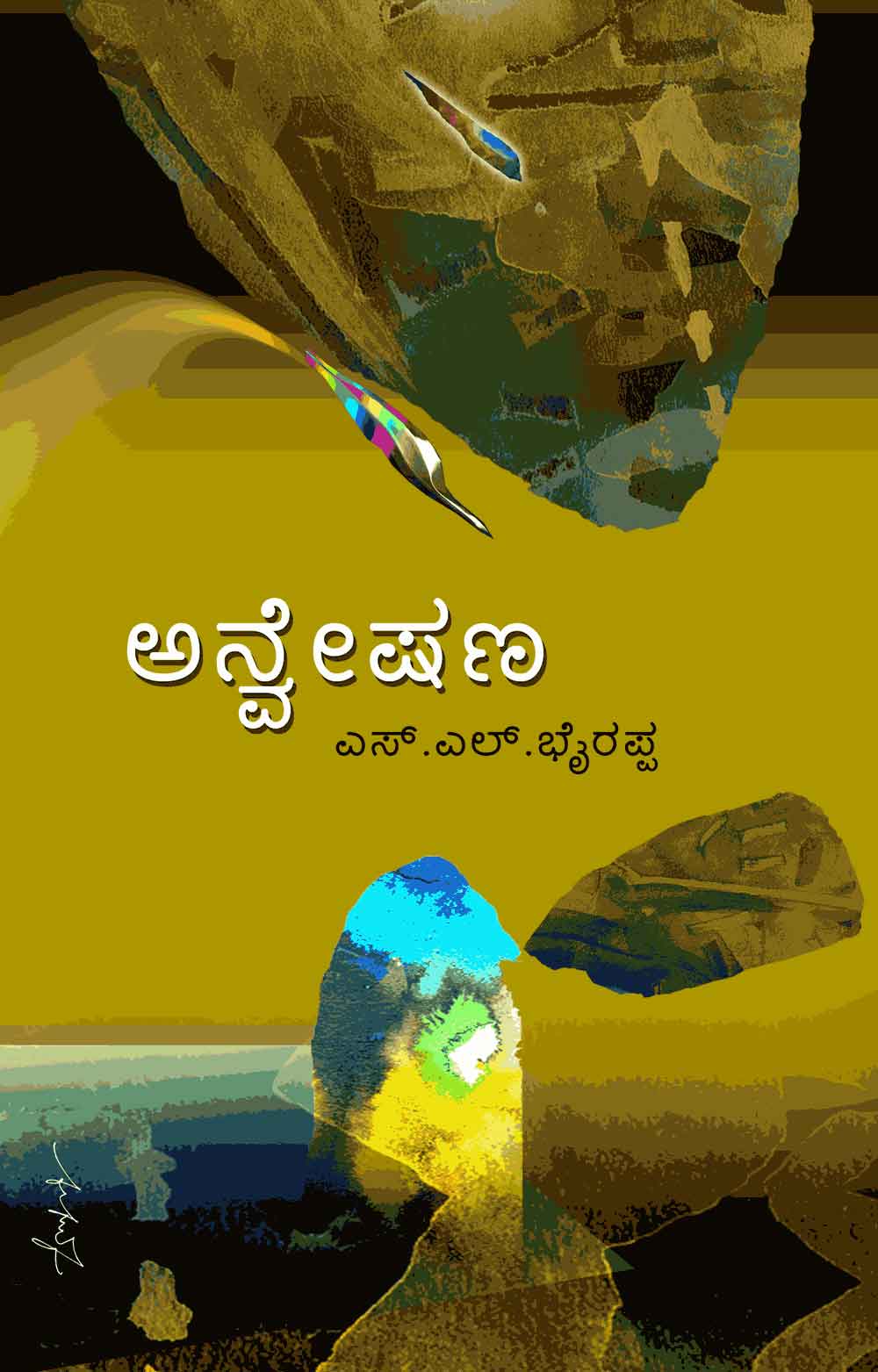ಹೆಸರಾಂತ ಕಾದಂಬರಿ ಗೃಹಭಂಗದ ಮುಂದುವರಿಕೆ 'ಅನ್ವೇಷಣ'. ೨೦೦ಕ್ಕಿಂತ ಕಡಿಮೆ ಪುಟಗಳಲ್ಲಿ ಕಥಾನಾಯಕ ವಿಶ್ವನಾಥನ ಜೀವನವನ್ನು ಒಂದು ವಿಶಿಷ್ಟವಾದ ಸಾಹಿತ್ಯಿಕ ಶೈಲಿಯಲ್ಲಿ ಭೈರಪ್ಪನವರು ಪ್ರಸ್ತುತಪಡಿಸಿದ್ದಾರೆ. ನಾನು ಗೃಹಭಂಗವನ್ನು ಓದಿಲ್ಲವಾದುದರಿಂದ ಕಾದಂಬರಿಗಳ ನಡುವೆ ಹೋಲಿಕೆ ನೀಡಲು ಸಾಧ್ಯವಿಲ್ಲ, ಆದರೆ, ಈ ಪುಸ್ತಕವನ್ನು ಓದಿದ ನಂತರ, ಮತ್ತು ಗೃಹಭಂಗವು ಗಿರೀಶ್ ಕಾಸರವಳ್ಳಿಯವರ ನಿರ್ದೇಶನದ ಪ್ರಸಿದ್ಧ ಧಾರಾವಾಹಿಯಾಗಿರುವ ತಿಳುವಳಿಕೆಯ ನಂತರ, ಈ ಪೂರ್ವಭಾವಿ ಹಾಗು ಭೈರಪ್ಪನವರ ಇತರ ಕಾದಂಬರಿಗಳನ್ನು ಓದುವ ಆಸೆ ಹೆಚ್ಚಾಗಿದೆ.
ಬಹು ನಿರೂಪಕರು
ಅನೇಕ ಭಾರತೀಯರಿಗೆ ಈ ನಿರೂಪಣಾ ಶೈಲಿ ತಿಳಿದಿಲ್ಲದ ಸಮಯದಲ್ಲಿ, ಈ ಸಾಹಿತ್ಯ-ಅಕಾಡೆಮಿ ವಿಜೇತ ಲೇಖಕರು ಅನೇಕ ನಿರೂಪಕರನ್ನು ಬಳಸಿದ್ದಾರೆ - ಕೆಲವೊಮ್ಮೆ ಮೊದಲ ವ್ಯಕ್ತಿ ಮತ್ತು ಕೆಲವೊಮ್ಮೆ ಮೂರನೇ ವ್ಯಕ್ತಿಯಲ್ಲಿ. ಗೃಹಭಂಗದಲ್ಲಿನ ಕೇಂದ್ರ ಪಾತ್ರವಾದ ನಂಜವ್ವನ ಮಗು ಈ ಕಾದಂಬರಿಯ ನಾಯಕ ವಿಶ್ವನಾಥ. ಇವನೊಂದಿಗೆ ಸಂಬಂಧ ಬೆಳೆಸಿಕೊಂಡ ಮತ್ತು ಅವನಿಂದ ಪ್ರಭಾವಿತರಾಗಿರುವ ವಿವಿಧ ಪಾತ್ರಗಳ ಮೂಲಕ ಓದುಗರಿಗೆ ಪರಿಚಯಿಸಲಾಗಿದೆ. ಕುದುರೆಯ ಮೇಲೆ ಪ್ರಯಾಣಿಸುವ ಒಂಟಿ ಬ್ರಾಹ್ಮಣ, ವಿದುರ ವಕೀಲ, ನಾಟಕ ಕಂಪನಿಯ ಶಿಕ್ಷಕ ಹಾಗು ಓರ್ವ ನಟಿ, ಒಬ್ಬ ಯೋಗಿ, ಸುಳ್ಳು ಭರವಸೆಗಳ ಮಧ್ಯೆ ವಿಶ್ವನಾಥನನ್ನು ಮದುವೆಯಾಗುವ ಯುವತಿ ಮತ್ತು ಒಬ್ಬ ಪ್ರಾಧ್ಯಾಪಕರು ಈ ಪುಸ್ತಕದಲ್ಲಿ ಕಾಣಿಸಿಕೊಳ್ಳುವ ಪ್ರಮುಖ ಪಾತ್ರಗಳು. ಕೊನೆಯ ನಿರೂಪಕ, ಪ್ರಾಧ್ಯಾಪಕ, ತನ್ನ ದಿನಚರಿಯಲ್ಲಿನ ಟಿಪ್ಪಣಿಗಳ ಮೂಲಕ ವಿಶ್ವನಾಥನನ್ನು ಅರ್ಥಮಾಡಿಕೊಳ್ಳಲು ಪ್ರಯತ್ನಿಸುತ್ತಿರುವ ಓದುಗನಿಗೆ ಸಂಕೇತವಾಗಿದ್ದಾನೆ. ಬದಲಾಗುತ್ತಿರುವ ಪ್ರತಿ ನಿರೂಪಕನೊಂದಿಗೆ ಲೇಖಕ ಕನ್ನಡ ಭಾಷಾ ಶೈಲಿಯನ್ನು ಬದಲಾಯಿಸುತ್ತಾರೆ. ಆತನ ಹೆಂಡತಿ ತನ್ನ ಜೀವನದ ಘಟನೆಗಳನ್ನು ಅರ್ಥ ಮಾಡಿಕೊಳ್ಳಲು ಪ್ರಯತ್ನಿಸುತ್ತಿರುವಾಗ ಅವಳ ಪ್ರಕ್ಷುಬ್ಧ ಭಾವನೆಗಳನ್ನು ವಿವರಿಸಿರುವುದು ಮೆಚ್ಚುಗೆಗೆ ಅರ್ಹವಾಗಿದೆ. ಇಲ್ಲಿ ಬಳಸಲಾಗುವ ಬಹು-ವ್ಯಕ್ತಿ ನಿರೂಪಣೆಯ ಜೊತೆಗೆ ಸಾಹಿತ್ಯಿಕ ವಿಧಾನ 'ಸ್ಟ್ರೀಮ್ ಆಫ್ ಕಾನ್ಷಿಯಸ್ನೆಸ್' (ವ್ಯಕ್ತಿಯ ಪ್ರಜ್ಞಾಪೂರ್ವಕ ಅನುಭವವನ್ನು ರೂಪಿಸುವ ಆಲೋಚನೆಗಳು ಮತ್ತು ಭಾವನೆಗಳ ನಿರಂತರ ಹರಿವು) ಕೇಂದ್ರ ಪಾತ್ರದ ಬಗ್ಗೆ ಮಾತ್ರವಲ್ಲದೆ ಪ್ರತಿ ನಿರೂಪಕನ ಸಾಮರ್ಥ್ಯ ಮತ್ತು ದೌರ್ಬಲ್ಯಗಳ ಬಗ್ಗೆಯೂ ತಿಳಿಸುತ್ತದೆ. ಪ್ರತಿಯೊಂದು ಅಧ್ಯಾಯವು ಉದ್ದವಾದ ಸಣ್ಣ-ಕಥೆಯಾಗಿ ಕಾರ್ಯನಿರ್ವಹಿಸುತ್ತದೆ. ಒಬ್ಬ ಪ್ರತ್ಯೇಕ ನಿರೂಪಕ, ಸನ್ಯಾಸಿಯಾಗಿದ್ದರೂ, ಅವರ ಅನುಭವವು ಆಸಕ್ತಿದಾಯಕವಾಗಿ ಹಾಸ್ಯಮಯವಾಗಿದೆ. ಮೊದಲ ಬಾರಿಗೆ ವೇಶ್ಯೆ ಬೀದಿಯಲ್ಲಿದ್ದಾಗ ಅವರ ಪ್ರತಿಕ್ರಿಯೆ, ವಿಶ್ವನಾಥನ ಮೇಲಿನ ವಿಚಿತ್ರ ಪ್ರೀತಿ-ದ್ವೇಷದ ಭಾವನೆಗಳು, ಅವನ ಬಗ್ಗೆ ಗೌರವ ಮತ್ತು ಅಸೂಯೆ ಇರುವುದರಿಂದ ಅವರು ತನ್ನ ಸ್ವಂತ ಗುರುತನ್ನೇ ಕಳೆದುಕೊಳ್ಳುವಂತಾಗುತ್ತದೆ. ಅವರ ಲೈಂಗಿಕ ಅನ್ವೇಷಣೆಯನ್ನು ಮನದಟ್ಟಾಗುವಂತೆ ಚಿತ್ರಿಸಲಾಗಿದೆ. ನಾನು ಒತ್ತಿ ಹೇಳಲು ಬಯಸುವ ವಿಷಯವೆಂದರೆ ಕಾದಂಬರಿಯು ಬಹು ಕಥೆಗಳನ್ನು ಹೊಂದಿಲ್ಲ ಆದರೆ ನಾಯಕನೊಂದಿಗಿನ ಅವರ ಅನುಭವಗಳ ಬಗ್ಗೆ ಆಲೋಚಿಸುವ ಮತ್ತು ಆತ್ಮಾವಲೋಕನ ಮಾಡುವ ವಿಭಿನ್ನ ಪಾತ್ರಗಳನ್ನು ಹೊಂದಿದೆ. ಪಾತ್ರ ಅಭಿವೃದ್ಧಿಗೂ ಸಹಕಾರಿಯಾಗಿದೆ.
ರೈಲುಗಳು
ರೈಲುಗಳ ಪುನರಾವರ್ತಿತ ಅಂಶ ಇರುವುದರಿಂದ ಕವರ್ ಪಿಕ್ಚರ್ ನಲ್ಲೂ ಹಾಕಬಹುದಿತ್ತು. ಪ್ರತಿ ಅಧ್ಯಾಯವು ಪ್ರತಿ ಪಾತ್ರದ ಮೂಲಕ ಆಲೋಚನೆಗಳ ರೈಲಿನಲ್ಲಿ ನಮ್ಮನ್ನು ತೊಡಗಿಸುತ್ತದಲ್ಲದೆ, ರೈಲುಗಳು, ಹಳಿಗಳು ಮತ್ತು ರೈಲ್ವೆ ನಿಲ್ದಾಣಗಳು ಆಗಾಗ್ಗೆ ಕಾಣಿಸಿಕೊಳ್ಳುತ್ತವೆ. ವಿಶ್ವನಾಥ ಅರಸೀಕೆರೆಯಿಂದ ರಾಣಿಬೆನ್ನೂರ್ಗೆ ರೈಲು ಹಳಿಗಳನ್ನು ಅನುಸರಿಸಿ ಕಾಲ್ನಡಿಗೆಯಲ್ಲಿ ಪ್ರಯಾಣಿಸುತ್ತಾನೆ. ಮುಂಬೈನಲ್ಲಿ, ರೈಲು ನಿಲ್ದಾಣದ ಹೊರಗೆ ಕುದುರೆ ಬಂಡಿಯ ಚಾಲಕನಾಗಿರುತ್ತಾನೆ. ಒಂದು ಸನ್ನಿವೇಶದಲ್ಲಿ ಆತನ ಪತ್ನಿ ರೈಲ್ವೆ ಹಳಿಯಲ್ಲಿ ಆತ್ಮಹತ್ಯೆ ಮಾಡಿಕೊಳ್ಳಲು ಪ್ರಯತ್ನಿಸುತ್ತಾಳೆ. ಬಹುಶಃ, ವಿಶ್ವನಾಥ ರಾಣಿಬೆನ್ನೂರ್ನಿಂದ ಮುಂಬೈಗೆ ಮತ್ತು ಚಿಕ್ಕಮಗಳೂರು, ಮೈಸೂರಿಗೆ ಜೀವನ ಅನ್ವೇಷಣೆಯತ್ತ ಸಾಗುತ್ತಿರುವ ಸಂದರ್ಭದಲ್ಲಿ 'ರೈಲು' 'ಪ್ರಯಾಣ'ಕ್ಕೆ ಸಮಾನಾರ್ಥಕವಾಗಿದೆ.
ನನ್ನ ನೆಚ್ಚಿನ ಕ್ಷಣಗಳು
ಬೆಟ್ಟಗಳಲ್ಲಿ ವಾಸಿಸುವ ಮನುಷ್ಯನ ಮನಸ್ಸಿನ ಸ್ಥಿತಿಯನ್ನು ವ್ಯಕ್ತಪಡಿಸಲು ಮೋಡಗಳು ಒಂದು ರೂಪಕವಾಗಿ ಬಳಸಲಾಗುತ್ತದೆ. ಅವನು ಬಿಳಿ ಮೋಡಗಳನ್ನು ಶಾಂತಿಯುತ, ಹಗುರವಾದ ಮನಸ್ಸಿನೊಂದಿಗೆ ಹೋಲಿಸುತ್ತಾನೆ, ಅದು ಗಾಳಿಯ ಸಣ್ಣದೊಂದು ತಳ್ಳುವಿಕೆಯೊಂದಿಗೆ ಚಲಿಸಿ, ಕ್ರಮೇಣ ಭಾರವಾಗಿ, ಭರ್ತ್ಸನೆ, ಖೇದ, ಹಿಂಸೆ, ಉನ್ಮತ್ತತೆಯಿಂದ ತುಂಬಿದ ಕಪ್ಪು ಮೋಡಗಳಾಗಿ, ಮೋಡಗಳು ಮಳೆಯಾಗಿ ಶುದ್ಧಿಯಾಗುತ್ತವೆ.ಸರಿಪಡಿಸಲಾಗದ ನಷ್ಟದ ಮಧ್ಯೆ ಬದುಕಲು ಪ್ರಯತ್ನಿಸುತ್ತಿರುವಾಗ ವಿಶ್ವನಾಥನ ಹೆಂಡತಿಯ ನೋವಿನ ಕ್ಷಣಗಳು ಹೆಂಡತಿ ಮತ್ತು ತಾಯಿಯಾಗಿರುವುದರಿಂದ ನನ್ನನ್ನು ತಳಮಳಗೊಳಿಸಿತು. ಪುಸ್ತಕ ಓದುವಾಗ ನಾನು ಕಣ್ಣೀರು ಸುರಿಸಿ ವರ್ಷಗಳೇ ಕಳೆದಿದ್ದವು.ಅವನು ತನ್ನ ಹೆಂಡತಿಗೆ ಬರೆದ ಪತ್ರದ ಕೊನೆಯ ಸಾಲುಗಳು: ಅವನು ಅವಳನ್ನು ಭೇಟಿಯಾದಾಗ ಅವಳು ಮಂಗಳಸೂತ್ರವನ್ನು ಧರಿಸಿರಲಿಲ್ಲವೆಂದು ಸಮಾಧಾನ ವ್ಯಕ್ತಪಡಿಸುತ್ತಾನೆ. ಸಮಾಧಾನ ಏಕೆಂದರೆ ಈಗ ಅವಳು ಸ್ವತಂತ್ರ ವ್ಯಕ್ತಿಯಾಗಿ ಅವನ ಬಳಿಗೆ ಹಿಂತಿರುಗುವ ನಿರ್ಧಾರವನ್ನು ತೆಗೆದುಕೊಳ್ಳಬಹುದೆಂದು. ಇದರ ಮುಂಚೆ ಒಂದು ಪ್ರಸಂಗದಲ್ಲಿ ಸಲಿಂಗಕಾಮಕ್ಕೆ ಸಂಬಂಧಿಸಿದಂತೆ "ವಿಕೃತ ಕಾಮ ಕೆಟ್ಟದ್ದು" ಎಂದು ಹೇಳಿರುತ್ತಾನೆ. ಆದರೂ, ತನ್ನ ಹೆಂಡತಿ ಸ್ವತಂತ್ರವಾಗಿ ನಿರ್ಧಾರ ತೆಗೆದುಕೊಳ್ಳಬೇಕೆಂದು ನಿರೀಕ್ಷಿಸುವುದು 1970 ರ ದಶಕದಲ್ಲಿ ಪ್ರಶಂಸನೀಯ ಸೂಚನೆಯಾಗಿದೆ.
ಲೇಖಕರು ಒಂದು ನಿರ್ದಿಷ್ಟವಾದ ಅಂತ್ಯವನ್ನು ಒದಗಿಸಿಲ್ಲ. ಸವಾಲಿನ ಸಂದರ್ಭಗಳನ್ನು ಎದುರಿಸುವಾಗ ಸೂಕ್ತ ಕ್ರಮ ತೆಗೆದುಕೂಳ್ಳಬೇಕಾಗುವ ಸಮಯದ ಅನಿರ್ಧಾರದ ಅಂತ್ಯ.
ಭೈರಪ್ಪನವರ ಬೇರೆ ಕೃತಿಗಳ ಬಗ್ಗೆ ನಿಮ್ಮ ಅನಿಸಿಕೆಗಳನ್ನು ತಿಳಿಸಿ.



